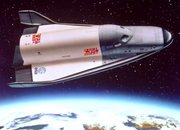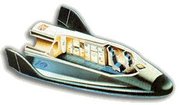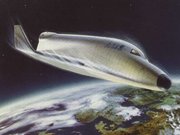Hermes (shuttle)
|
|
Hermes was a proposed mini-shuttle designed by the European Space Agency that externally had a lot of similiarities with the US X-20. The project started in November 1987, scheduled for service in 1995, but was finally terminated in 1993 after changes in the financial and political landscape had removed the arguments for Hermes. No Hermes shuttles were ever built.
| Contents |
Configuration
Hermes was to be launched on top of an Ariane 5 launcher and would consist of two parts: One part, a cone-shaped attachment named the Resource Module, would be left behind before re-entry. Only the space plane itself would re-enter Earth’s atmosphere and land.
In the configuration envisioned prior to project termination, Hermes would carry three astronauts and a 3,000 kg pressurised payload. The final launch weight would be 21,000 kg., which was seen as the upper limit of what even an extended Ariane 5 could lift.
Development
To ensure European autonomous access to space, in the mid 1980s the French space agency CNES pushed for a European shuttle mimicking those of Russia and the USA. The European Space Agency officially started the project, dubbed Hermes, in November 1987. It was envisioned that Hermes would service a small space station, Columbus_orbital_facility, built primarily by the German and Italian space agencies and that first launch would be in 1998.
Hermes was to be developed in two phases.
- Phase 1: Study and pre-development. This phase was scheduled to end in 1990. Initially the plans called for a capacity to lift 6 astronauts and 4,550 kg of cargo, but after the Challenger disaster, it was felt necessary to include ejection capacity of some form to give astronauts at least a small chance of survival in case of catastrophe. Accordingly the six seats were now curtailed to only three regular ejection seats, which were chosen over an entirely ejecting crew capsule that would have given the crew an escape option at heights over 28 km. The cargo capacity was limited to 3,000 kg.Missing image
Hermes_launch.jpgArtist's impression of a Hermes launch. Notable here is the Resource Module attached behind Hermes on top of the Ariane 5 launcher
Hermes would not be able to place objects into orbit as its cargo hold could not be opened; again this option was abandoned due to weight concerns.
Although Hermes was originally seen as being entirely reusable (up to 30 successive re-entries without major servicing), problems aligning the capacity of the Ariane 5 launcher with the design of Hermes itself forced it to leave behind its back part, the Resource Module, before re-entry. A newly built resource module would then be attached to the Hermes space plane and the entire structure would be launched again.
Phase 1 did not complete until the end of 1991 and by then the political climate surrounding Hermes had changed considerably. The Iron Curtain had been lifted and the Cold War was ending. As a result, ESA decided to interject a year long “reflection” period to examine if it still made sense for Europe to build its own space shuttle and space station or if new partners could be found to share cost and development.
Officially, phase 1 completed at the end of 1992, after a year of reflection.
- Phase 2: Final development, manufacture & initial operations. This phase was never properly started, as ESA and the Russian Aviation and Space Agency (RKA) had agreed to cooperate on future launchers and a replacement space station for Mir. Economic concerns prevented RKA from properly participating in a future launcher program, but at this point most of ESA’s crew transport capabilities had been reoriented towards a capsule type system (as opposed to the glider system that Hermes represented) which was what the joint Russian/European designs called for.
When both Russia and ESA joined up with NASA to build the International Space Station, the immediate need for a European crew transport system disappeared as both Russia and the USA had existing capabilities that did not need expansion. Accordingly ESA decided to abandon the Hermes project. No part of Hermes was ever built.
Partners
The primary companies involved in Hermes were Aerospatiale and Dassault, both French. Arianespace built the Ariane 5 launcher and was seen as a strong candidate for running the Hermes infrastructure. No contract was ever signed, however.
Future
European launcher endeavors now circle around Phoenix of EADS SPACE Transportation and DLR at ESA.de:Hermes (Raumfähre) fr:Hermès (navette spatiale) pt:Hermes (vaivém)



